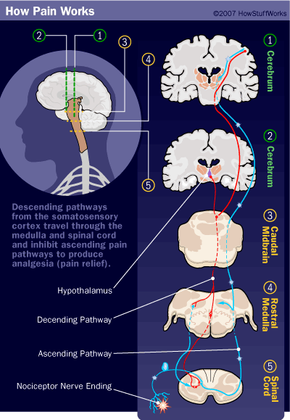Pain Pathway
Once the pain information is in the brain, we're not quite sure how it gets processed. Obviously, some signals go to the motor cortex, then down through the spinal cord and to the motor nerves. These impulses would cause muscle contractions to move your hand out of the way of whatever is causing the pain.
However, several observations lead scientists to think that the brain can influence pain perception.
Advertisement
- The pain from the cut on your hand eventually subsides or reduces to a lower intensity.
- If you consciously distract yourself, you don't think about the pain and it bothers you less.
- People given placebos for pain control often report that the pain ceases or diminishes.
This indicates that pain-influencing neural pathways must exist from the brain downward.
These descending pathways originate in the somatosensory cortex (which relays to the thalamus) and the hypothalamus. Thalamic neurons descend to the midbrain. There, they synapse on ascending pathways in the medulla and spinal cord and inhibit ascending nerve signals. This produces pain relief (analgesia). Some of this relief comes from the stimulation of natural pain-relieving opiate neurotransmitters called endorphins, dynorphins and enkephalins.
Pain signals can set off autonomic nervous system pathways as they pass through the medulla, causing increased heart rate and blood pressure, rapid breathing and sweating. The extent of these reactions depends upon the intensity of pain, and they can be depressed by brain centers in the cortex through various descending pathways.
As the ascending pain pathways travel through the spinal cord and medulla, they can also be set off by neuropathic pain -- damage to peripheral nerves, spinal cord or the brain itself. However, the extent of the damage may limit the reaction of the brain's descending pathways.
The influences of the descending pathways might also be responsible for psychogenic pain (pain perception with no obvious physical cause).
Thoughts, emotions and "circuitry" can affect both ascending and descending pain pathways. So, several factors, physiological and psychological, can influence pain perception:
- Age -- Brain circuitry generally degenerates with age, so older people have lower pain thresholds and have more problems dealing with pain.
- Gender -- Research shows that women have a higher sensitivity to pain than men do. This could be because of sex-linked genetic traits and hormonal changes that might alter the pain perception system. Psychosocial factors could be at work, too -- men are expected not to show or report their pain.
- Fatigue -- We often experience more pain when our body is stressed from lack of sleep.
- Memory -- How we have experienced pain in the past can influence neural responses (memory comes from the limbic system).
